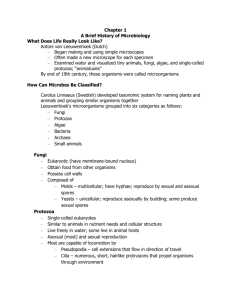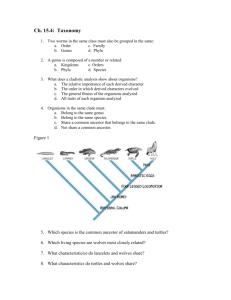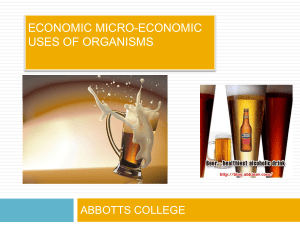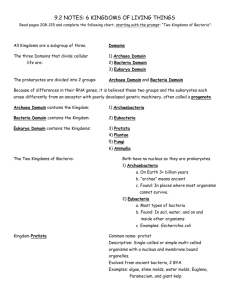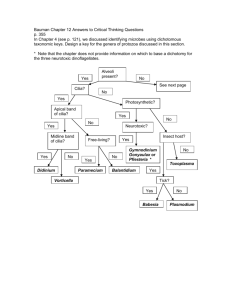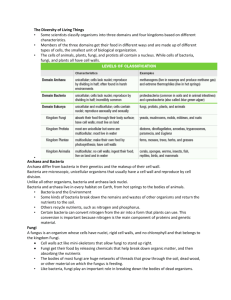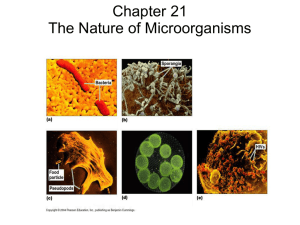Chapter 21
advertisement
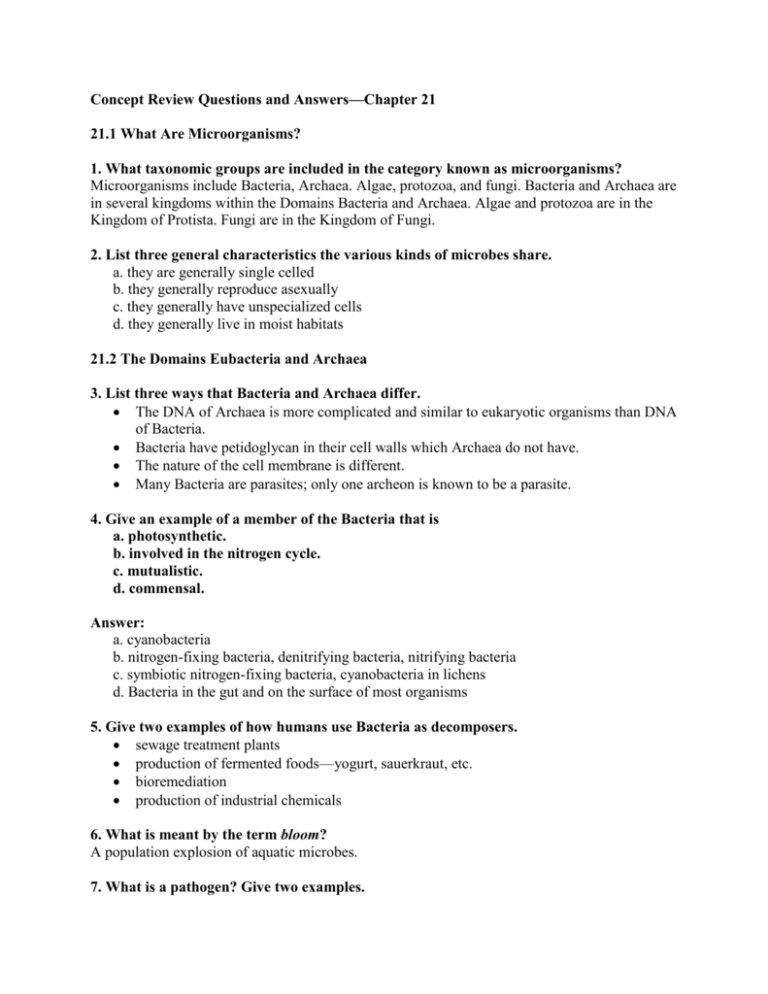
Concept Review Questions and Answers—Chapter 21 21.1 What Are Microorganisms? 1. What taxonomic groups are included in the category known as microorganisms? Microorganisms include Bacteria, Archaea. Algae, protozoa, and fungi. Bacteria and Archaea are in several kingdoms within the Domains Bacteria and Archaea. Algae and protozoa are in the Kingdom of Protista. Fungi are in the Kingdom of Fungi. 2. List three general characteristics the various kinds of microbes share. a. they are generally single celled b. they generally reproduce asexually c. they generally have unspecialized cells d. they generally live in moist habitats 21.2 The Domains Eubacteria and Archaea 3. List three ways that Bacteria and Archaea differ. The DNA of Archaea is more complicated and similar to eukaryotic organisms than DNA of Bacteria. Bacteria have petidoglycan in their cell walls which Archaea do not have. The nature of the cell membrane is different. Many Bacteria are parasites; only one archeon is known to be a parasite. 4. Give an example of a member of the Bacteria that is a. photosynthetic. b. involved in the nitrogen cycle. c. mutualistic. d. commensal. Answer: a. cyanobacteria b. nitrogen-fixing bacteria, denitrifying bacteria, nitrifying bacteria c. symbiotic nitrogen-fixing bacteria, cyanobacteria in lichens d. Bacteria in the gut and on the surface of most organisms 5. Give two examples of how humans use Bacteria as decomposers. sewage treatment plants production of fermented foods—yogurt, sauerkraut, etc. bioremediation production of industrial chemicals 6. What is meant by the term bloom? A population explosion of aquatic microbes. 7. What is a pathogen? Give two examples. Pathogens are organisms capable of causing disease, ex. the bacterium Staphylococcus aureus and the protozoan Plasmodium vivax 8. Define the term saprophyte. Organisms that decompose dead material, sewage, and other wastes into simpler molecules that can be recycled. 9. What is a bacterial endospore? A unique bacterial structure with a low metabolic rate that can germinate under favorable conditions to form a new, actively growing cell. 10. What are methanogens? Methanogens are Archaea that release methane as a product of their metabolism. 11. Describe how members of the Archaea are involved in the nitrogen cycle. Many Archaea are involved in several steps in the nitrogen cycle in the ocean. 12. Describe 3 roles played by Archaea in the ocean. They are important organisms at the base of the food chain around hydrothermal vents. Many are photoautotrophs or chemoautotrophs in the ocean. Many are decomposers. Some are involved in various stages of the nitrogen cycle. 13. What is a thermophile? A halophile? A thermophile is an organism that thrives at high temperatures. A halophile is an organism that thrives at high salinity. 21.3 The Kingdom Protista 14. Why is the kingdom Protista not considered a valid phylogenetic group? The protozoa and algae differ in many ways; algae have cell walls—protozoa do not, algae are photosynthetic—protozoa are not, protozoa consume food—algae do not. 15. What is phytoplankton? Small floating or weakly swimming plants. 16. List three different categories of organisms that are considered algae. Diatoms, Dinoflagellates, Green Algae, Red Algae, Brown Algae 17. List two major kinds of marine phytoplankton. Diatoms and Dinoflagellates 18. List the two major kinds of multicellular marine algae. Brown algae and red algae 19. Describe a characteristic for each of the following: a. Apicomplexa b. Ciliates c. Flagellates d. Foraminifera Answer: a. Apicomplexa—are parasites; complex life cycles b. Ciliates—have many hair-like cilia; complex cell structure c. Flagellates—Long whip-like flagella d. Foraminifera—shells surround the cell; thin pseudopods; zooplankton 20. Why are water molds and slime molds not considered to be Fungi? They have cellulose, not have chitin in their cell walls; they have reproductive cells that have flagella which fungi do not have. 21.4 Multicellularity in the Protista 21. Why do biologists think that the ancestors of plants, animals, and fungi could have been Protista? Many kinds of organisms in the Protista are composed of groups of cells with some degree of specialization. 21.5 The Kingdom Fungi 22. Name two beneficial results of fungal growth and activity. a. carbon dioxide production for the leavening of bread dough b. the production of antibiotics c. they serve as decomposers 23. Why are spores important in the life cycle of fungi? a. Spores can be easily distributed by wind, rain, and animals. b. Spores are reproductive structures. 24. Describe the role of fungi in lichens and mycorrhiza. Lichens—The fungi provide a moist environment for the growth of algae. Mycorrhiza—The fungi increase the surface area of roots so that plants can more efficiently obtain water and nutrients. 25. How do fungi obtain food? They release digestive enzymes around them and absorb the digested food into their cells. 26. What kinds of organisms are most affected by parasitic fungi? Plants
